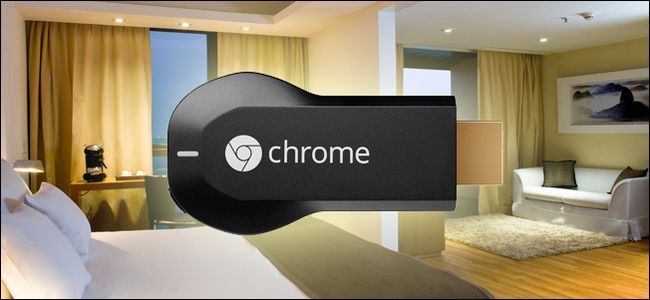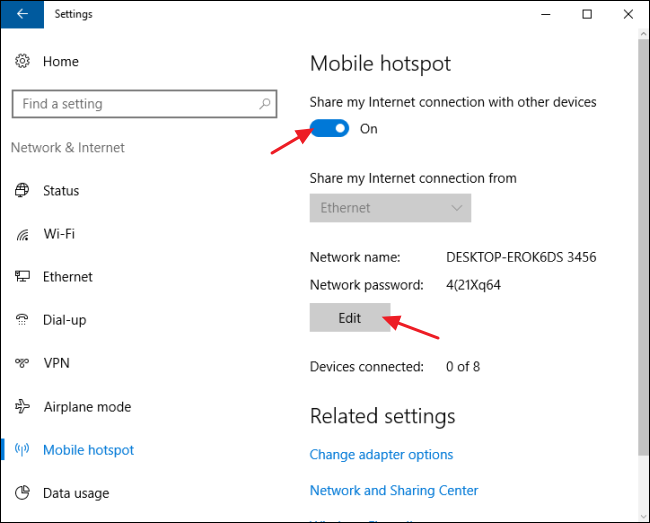Quick Links
If you've gotten a wee bit addicted to your Chromecast (and we hardly blame you, it's a fantastic little device) you might want to take it on the road with you. If you're headed to a friend's house, you shouldn't have any issues. If you're headed to a hotel, however, there are plenty of pitfalls. Read on as we show you how to use the Chromecast in a hotel room.
Dear How-To Geek,
I travel a lot for work, and I would really like to use my Chromecast when I'm on the road. The pay-per-view movies are still just as big of a rip off as they were twenty years ago and the variety is limited. It seems really silly to pay $5 or more for a movie when I can (assuming I ever get it to work) just use my Chromecast and go crazy watching Netflix.
I've taken it with me a few times but I've never managed to get it up and running. I figured you guys would have an idea or two and might be able to help me get this show on the road. How can I get the Chromecast to work when I'm away from home and in a hotel room where I don't have any control over the Wi-Fi network?
Sincerely,
Chromecast Travelin'
We fully understand your desire to take the Chromecast on the road. Not only is the Chromecast awesome and a great way to stream media, once you're used to how convinient it is the cruddy content on basic cable (and the expense of paying for movies in hotels) becomes unbearable.
Before we dig into potential solutions, let's outline what you need to make the Chromecast work and where the pitfalls lie. Once you have a solid understanding of what the Chromecast needs to function smoothly you can better evaluate the potential solutions and even come up with some of your own.
The Easy Way: Set Up a Wi-Fi Hotspot Using Your Laptop
Connecting your Chromecast through the hotel is going to be a pain or require special hardware -- keep reading if you want to learn all the rest of the details. But there's a simpler solution, which is to simply create a Wi-Fi hotspot from your laptop and connect the Chromecast through your laptop instead.
Windows 10 has a built-in feature called "Mobile Hotspot" that can do this in just a few clicks. Just follow these steps:
- Head to Windows' settings by pressing Windows+I on your keyboard.
- Go to Network & Internet > Mobile Hotspot.
- Click the "Edit" button to change your hotspot's name and password, and flip the switch to "On" when you're ready.
From there, you can connect your Chromecast to the hotspot broadcasted by your laptop.
This is a bit more complex in Windows 7 and 8, but you can check out our full guide for instructions on every operating system.
And if you are at a hotel that charges per-device, this can get all your devices online for the price of one, which is pretty handy.
How the Chromecast Works and Away-from-Home Networking Woes
The basic setup of the Chromecast system is simple. Upon first configuration, the Chromecast itself acts like a micro hotspot for the express purpose of you connecting to the Chromecast to configure it and tell it how to connect to a larger and more functional network. You plug in the credentials for the Wi-Fi network you want it to use, and it connects to that network. From that point forward as long as you are also on that network (and can access the Chromecast across the network) you can control it.
What you'd like to do, transport this setup away from your home to a hotel room, is in fact doable but not by setting up the Chromecast in the traditional fashion. While you might be able to recreate the simple at-home setup if you happen to be staying in a bed and breakfast or a small non-chain hotel with simple Wi-Fi configurations, the simple setup process falls apart in large hotel chains with managed infrastructures.
There are two fundamental problems inherent in setting up a Chromecast on a hotel Wi-Fi network. First, the network may have AP/client isolation turned out wherein any client on the Wi-Fi network is isolated from any other client. This is a good security measure that prevents other hotel guests from gaining access to your devices (if you, for example, mistakenly turned on network sharing for the Wi-Fi network and left your shared folders wide open). Unfortunately AP isolation completely breaks the Chromecast as it needs to talk to other devices on the network (specifically to the smartphone, tablet, or computer you're controlling it with). There's no way to work around that limitation without bringing in additional hardware.
The second problem is the issue of authentication splash screens wherein you can log into the Wi-Fi freely but you need to first stop off at a splash page and accept terms of service, plug in your room number, or otherwise authenticate yourself as a valid user of the Wi-Fi system. This bit is a pain but you can, in fact, work around it with a little creativity.
Let's take a look at several ways you can get the Chromecast online in your hotel room and you can select the fit that's best for your budget and patience.
Deploy a Portable Router
Most modern hotel rooms have Ethernet jacks. In an age when everyone is connecting wireless and the bulk of a hotel's security efforts are focused on the wireless network, Ethernet jacks represent a sort of portal to Narnia where the data flows free and fast. In our experience the Ethernet jacks in hotel rooms are very rarely secured in any fashion and you can simply plug in a device and go.
How does this benefit you in your quest to get the very Wi-Fi only Chromecast online? It benefits you because you can bridge the Wi-Fi gap on your own terms by using a travel router. All you need is a compact travel router like the HooToo Tripmate (a great little router we reviewed earlier this year and gave solid marks), an Ethernet cable, and you're ready to rock. Just plug in the portable router to the Ethernet jack in your room (you may have to steal the port from the cable box or other networked device in the media center, but we won't tell), fire up the router, and connect to the router with your smartphone, tablet, or computer to configure the Chromecast just like you would at home.
In fact you can even do a dry run at home where you get all the configuration done ahead of time (this way when you plug the router and Chromecast in at the hotel they'll automatically start talking to each other).
Although its rare, if the hotel does have a login/authentication splash page for Ethernet users you can simply visit it with one of your devices (while connected to the wi-fi router). The router has a single IP/MAC address and doles out access (just like your home router) to all the attached devices. Once you accept the terms of agreement with one device through the unified access point the security system will let anything connected to the portable Wi-Fi router, including the Chromecast, pass through just fine.
This is the technique we recommend as it works in practically any room with an Ethernet jack and, if you do the initial setup at home, is essentially just plug and play. You can go from no Chromecast to Chromecast access is less than a minute. This is also the only technique that allows you to use the hotel's data network in the face of (all-too-common) AP isolation.
If you like this method but you're not too keen on shelling out cash for a portable router, you might consider the free (but slightly more complicated) methods that involve turning your hard-wired laptop into a Wi-Fi hotspot. Check out tutorials on the subject here and here.
Circumvent the Splash Screen by Cloning Your MAC Address
Let's say you're in a hotel that doesn't have AP isolation turned on. That's great because it means your Chromecast and controlling device (like your laptop or phone) can talk to each other. You still have a big problem, however, if the hotel has a authentication splash screen: there's no way for the Chromecast to navigate the authentication process.
Here's where you have to get creative. The authentication process is almost always linked to the MAC address of the device attaching itself to the network. During the Chromecast setup process the MAC address of the Chromecast is displayed in the lower corner of the Wi-Fi configuration screen. In order to trick the network into letting your Chromecast join, you can spoof the MAC address of the Chromecast on your laptop or portable device and complete the authentication process on the Chromecast's behalf. First, check out our guide to spoofing MAC addresses here or look up a guide for your specific portable device. Second, follow these steps.
- Plug in the Chromecast and complete the setup steps far enough along to see the MAC address (or if you have super sharp eyes, read it off the back of the dongle).
- Turn the Chromecast off.
- Use the appropriate tool or settings menu on your device to change the MAC address of your device to the MAC address of the Chromecast.
- Open a web browser and complete the authentication process.
- Change your device's MAC address back to it's original address. (Rebooting may be required.)
- Authenticate the device with its original MAC address.
- Plug the Chromecast back in.
At this point both your devices (the Chromecast and controlling device) will be on the network. Some networks have expiring authentication (24 hours typically) so you'll need to repeat this process each day. It's inconvenient and it only works if the Wi-Fi network has AP isolation turned off.
Use Your Hotspot and Skip the Hotel Network Altogether
If the hotel network is more hassle than you care to deal with, you can skip it altogether by using a hotspot service. Many cellular providers offers phone-as-hotspot or even dedicated hotspots (like the MiFi) that allow you to connect your wireless devices to the hotspot which in turn pulls data off the cellular network.
This technique certainly works but its our least favorite of all the options for several reasons. First, if you're doing internet-based streaming (instead of streaming local content from your laptop or phone) you're going to chew up bandwidth really fast. Unless you're one of those rare grandfathered-in "unlimited" AT&T subscribers that means you're going to likely burn through your entire month's data allotment with a single night of Netflix. Second, it puts you at the mercy of cellular network quality which (compared to even lackluster local network access) is rubbish.
The above tips and tricks should get you up and running in no time. Before we leave the subject, however, we have one useful bit of distinctly non-technical advice: bring a screw driver. Many hotel chains have security plates screwed down onto the port/cord areas of their HDTV sets, ostensibly to keep patrons from messing with the cables and necessitating service calls. In such cases you'll need to do a little unlocking before you can pop your Chromecast into the HDMI port. Good luck!


